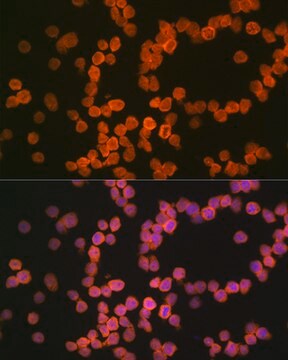ZMS1076
Anti-SARS-CoV-1/2 S Protein Antibody, clone 2B3E5 ZooMAb® Mouse Monoclonal

recombinant, expressed in HEK 293 cells
Synonym(s):
Coronavirus S protein, Cov-2 S protein, E2, Peplomer protein, S glycoprotein, SARS-CoV 1/2 Spike glycoprotein
About This Item
Recommended Products
biological source
mouse (recombinant)
Quality Level
recombinant
expressed in HEK 293 cells
conjugate
unconjugated
antibody form
purified antibody
antibody product type
primary antibodies
clone
2B3E5, recombinant monoclonal
product line
ZooMAb® learn more
form
lyophilized
mol wt
calculated mol wt 139.13 kDa (SARS-CoV)
calculated mol wt 141.18 kDa (SARS-CoV-2)
observed mol wt ~230 kDa
species reactivity
SARS virus
packaging
antibody small pack of 25 μL
greener alternative product characteristics
Waste Prevention
Designing Safer Chemicals
Design for Energy Efficiency
Learn more about the Principles of Green Chemistry.
enhanced validation
recombinant expression
Learn more about Antibody Enhanced Validation
sustainability
Greener Alternative Product
technique(s)
ELISA: suitable
affinity binding assay: suitable
flow cytometry: 1 μg/mL
western blot: 1:5,000
isotype
IgG2aκ
greener alternative category
, Aligned
shipped in
ambient
storage temp.
2-8°C
target post-translational modification
unmodified
Gene Information
SARS coronavirus ... S(43740568)
SARS virus ... S(1489668)
General description
Each ZooMAb antibody is manufactured using our proprietary recombinant expression system, purified to homogeneity, and precisely dispensed to produce robust and highly reproducible lot-to-lot consistency. Only top-performing clones are released for use by researchers. Each antibody is validated for high specificity and affinity across multiple applications, including its most commonly used application. ZooMAb antibodies are reliably available and ready to ship when you need them.
Learn more about ZooMAb here.
Specificity
Immunogen
application
Flow Cytometry Analysis: 1 μg/mL from a representative lot detected SARS-CoV-1/2 S protein in Transfected 293 cells (Courtesy of Dr Thomas Moran, Center for Therapeutic Antibody Development).
Western Blotting Analysis: 1 μg/mL from a representative lot detected SARS-CoV-1/2 S Protein in Vero E6 cells +/- SARS-Cov-2 infection (Courtesy of Jeff Johnson Laboratory, Icahn School of Medicine at Mount Sinai (ISMMS).
ELISA Analysis: A multiple Dilution from a representative lot detected SARS-CoV-1/2 S Protein in S1 fusion protein (Courtesy of Dr Thomas Moran, Center for Therapeutic Antibody Development).
Note: Actual optimal working dilutions must be determined by end user as specimens, and experimental conditions may vary with the end user
Target description
Physical form
Reconstitution
Storage and Stability
Legal Information
Disclaimer
Data presented is the available current product information and provided as-is. These products have not been tested or verified in any additional applications, sample types, including any clinical use. Experimental conditions must be empirically derived by the user. Our Antibody Guarantee only covers tested applications stated herein and conditions presented in our product information and is not extended to publications.
Not finding the right product?
Try our Product Selector Tool.
Storage Class
11 - Combustible Solids
wgk_germany
WGK 1
flash_point_f
Not applicable
flash_point_c
Not applicable
Certificates of Analysis (COA)
Search for Certificates of Analysis (COA) by entering the products Lot/Batch Number. Lot and Batch Numbers can be found on a product’s label following the words ‘Lot’ or ‘Batch’.
Already Own This Product?
Find documentation for the products that you have recently purchased in the Document Library.
Our team of scientists has experience in all areas of research including Life Science, Material Science, Chemical Synthesis, Chromatography, Analytical and many others.
Contact Technical Service





